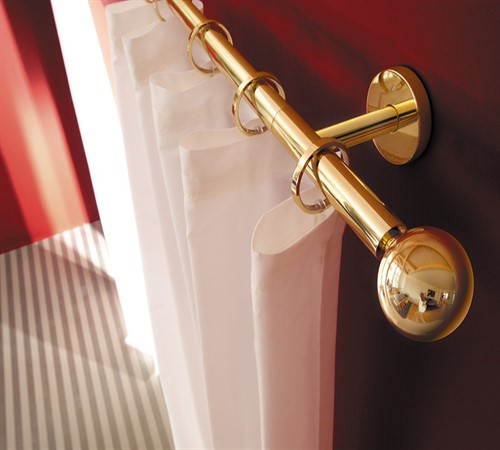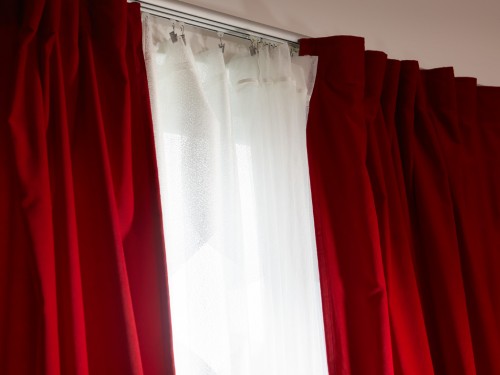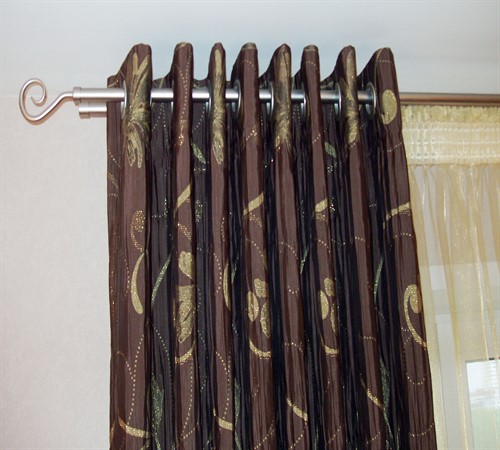An important element of the interior design is the curtains that give the room completed. However, how the scenery of the curtain will look like in the final version, largely depends on the eaves and the method of its fastening.
Content
Types of Karnizov
Currently, a rather diverse range of eaves, affecting its sophistication and uniqueness, which can be grouped relative to a certain feature.
Classification of cornices by material
- Plastic is the most common option due to the abundance of various forms, colors and low cost. However, under the weight of heavy porter, the deformation of the eaves with time is not excluded.
- Wooden - a combination of functionality, reliability, aesthetics. Eaves of wood produced by the most diverse shape can be additionally decorated with decorative carvings. In addition, they are perfectly withstanding the weight of heavy porter without any deformation.
- Metal cornices are made of steel, brass or aluminum and can be decorated with plastic or wooden elements. At the same time, steel and brass eaves easily withstand even heavy theatrical corders, while aluminum are designed for easier curtains. Special attention in this category deserve forged eaves, distinguished by special strength and unique design.
Classification of eaves for constructive features
1. Profile eaves are made of aluminum, plastic, with any way of fastening the eaves, characterized by small dimensions, low cost and ease of installation. In addition, profile eaves are easy enough to hide in the ceiling niche either dragged with lambrequins or by hanging the barn plank. Profile cornices are divided into:
- hard eaves with one internal rail - consists of a single-row rail, as well as latches for fastening to the brackets. To create additional rows, such eaves are equipped with decorative models;
- flexible eaves with an external rail - is available only to one-row, but it is easy to bend, cut, which contributes to the simplicity of installation. To obtain additional rows, the required number of profiles is established in parallel;
- flexible eaves with internal rail - the bending of the eternity attached in the factory conditions, forming the shape of the erker, arches, or combinations of the erker and the arch. Moreover, the cornice with arched bent may be a double row, and only a single-row cornice;
- tire cornice - it is impossible to bend. However, the connecting rotary element is additionally used to obtain an aircraft cornice.
2. Baged - produced in the form of a decoratively decorated plank, reliably hiding the brackets. Regarding other species, bagent eaves have a low cost. Although the design is not inferior to a profile, nor rod cornices. 
3. Rodary eaves are presented in the form of a rectangular, round or curly section. Produced from wood or metal. The kit, as a rule, includes brackets, curtain holders and tip. To mount the rod to the wall, the ceiling is equipped or closed brackets. 
4. String - used for light tower curtains. This is a relatively cheap option, of all available categories, and the most unreliable, because even under a slight weight of the string begins to sagging over time and it is necessary to constantly pull it. 
Classification of eaves regarding the number of rows
- Single row eaves - for attaching one tulle or curtains.
- Double-row - designed for mounting curtains and tulle.
- Three-rowed eaves - open the ability to decorate the interior of the room as a seal, curtains and lambrene.
Classification by fastening method
The attachment of the eaves directly depends on the material used to finish the ceiling, walls.
1. Ceiling eaves, attaching directly to the ceiling, open up wide opportunities for creating original design. Especially indispensable, they are in the presence of high windows that do not leave spaces for fastening wall curtains. In addition, the appearance of ceiling eaves allowed to resolve many problems arising from the use of wall cornice. 
Advantages of ceiling eaves relative to wall:
- contribute to visual increase in space space;
- large selection of color scheme;
- the possibility of hidden editing;
- the ability to withstand high curtain weight;
- arbitrary selection of the distance from the wall to the eaves, allowing you to hide pipes and heating radiators behind the curtains;
- the ability to conceal small drawbacks left after the ceiling finishes;
- low cost.
Disadvantages:
- modest design;
- limit of installation with the immediate location of the light bulbs in the ceiling, decorated with plasterboard.
- the impossibility of mounting in the presence of stretch ceilings, with a non-equipped place to make fixtures.
2. Wall-mounted eaves, for the first time produced several centuries ago, still enjoy high demand. Moreover, the decorativeness of modern wall-mounted eaves does not require concealing their appearance in the cornices. 
Pluses of wall curtains in front of ceiling:
- wide selection of color scheme;
- originality of design;
- efficiency due to a decrease in fabric consumption to tailoring curtains;
- the ability to mount to the wall in the ceiling niche;
- ease of installation;
- high cost relative to ceiling eaves.
Minuses:
- visually somewhat reduce the height of the room;
- the need to carefully measure the required bracket length to avoid subsequent curtain inflection of the protruding radiators of heating, the angles of window protrusions.
Thus, the choice of the design of the ceiling or wall cornice depends largely on the interior style, the type of curtains, as well as the attachment of the finished curtains to the eaves.
Installation of ceiling cornice
Today, the ceilings are put to putty with subsequent staining, drywall, cladding with tension ceilings. Based on this, the methods for fastening the eaves to the ceiling are also significantly different. The optimal location of the ceiling cornice is selected based on the following factors:
- the length of the eaves should be more window opening by 30-50 cm;
- in the closed state, the curtains should not touch the protruding wall elements.
To the concrete ceiling, or plasterboard
If it is a binary type cornice, then:
- Measure and cut off the desired length of the eaves.
- Wash the hooks if the cornice model on the edges is extended by curved parts.
- Drill in the middle of the tire hole using 2 drills of different diameters. First, the drill, slightly exceeding the diameter of the screw screw or screw, the hole is made with the front side of the eaves so that the hat is drowned somewhat at the base of the cornice. Then the hole is reserved by the drill of a smaller diameter.
- In 50-60 cm increments, drill such holes along the entire length of the eaves. However, with a single-row open-row openings, it is enough to do in 1 row, and with a multi-row - in 2 rows or zigzag.
- Attach the cornice to the place marked for it on the ceiling.
- Pencil make the mark of the central opening and drill it to the depth of the dowel.
- Drown a dowel in the hole with a hammer.
- Fasten the tire on the central attachment and make marks along the entire bus length.
- Drill the remaining holes and secure the tire on the ceiling.
In the case of a suspended ceiling of drywall, instead of ordinary dowels, a dowel-"Butterfly" is used. When screwing, falling into an empty space, a dowel-"butterfly" is revealed similar to the umbrella, increasing the area of \u200b\u200bthe load on plasterboard.
When using the ceiling cornice, which is fixed to the ceiling by means of brackets, the task is greatly facilitated because there are finished holes in the brackets. It remains:
- collect cornice;
- make the ceiling markup in the mounting places of brackets;
- apply the collected eaves to the markup on the ceiling;
- outline and drill holes;
- attach the cornice to the ceiling using ordinary dowels or dowels - "butterflies".
To stretch ceiling
The mounting of the ceiling eaves to the stretch ceiling implies the mount to the mortgage bar located between the capital and stretch ceiling. At the same time, the mortgage bar must be reliably attached to the capital ceiling until the measurement of the stretch ceiling measurements. The size of the bar must correspond to the height of the frame required during the tension of the plastic canvas. Thus, the measureer will indicate the location of the future eaves in the scheme and in the manufacture of the ceiling, the cloth in this place will be strengthened additionally. After installing the stretch ceiling:
- Place on a tensioned film as part of the mortgage bar of the place of attachment of the eaves.
- Before drilling, the holes in the stretch ceiling must be pre-strengthened with polymer rings, and then burn.
- Drill holes to the depth of dowels.
- Install cornice.
Installation of wall cornice
All types of eaves whose fastenings suggest wall mounting are almost the same. The correct installation of the wall cornice implies compliance with the following conditions:
- The cornice should perform at 30-50 cm on both sides of the window opening, so that when opening a curtain, sunlight hit the room through the entire window opening.
- The minimum distance from the ceiling to the karnis installed, as well as from the window to the eaves is at least 5-10 cm.
- Heating radiators and other speakers from the wall elements should not interfere with the free hang of curtains, so you need to select the brackets, focusing on this factor.
- For a reliable attachment of the cornice designed for the medium gravity curtain, the brackets must be placed every 1.5 m, and for more heavy curtains after 1 m.
To Wall
All brackets have finished openings for fastening the eaves, so it is necessary:
- Connect the cornice with brackets.
- Enclose to the wall and outline spaces for drilling holes.
- Drill, insert ordinary dowels or a dowel-"butterfly", based on the finishing material.
- Fight cornice.
Between the walls
When attaching the eaves between the walls, distances on each side of the wall are carefully measured:
- from the ceiling to the fastening of the cornice;
- from the wall with window opening to the place of attachment of the cornice.
It is necessary to avoid deviation from the horizontal position.
- Note the places of future holes.
- Drill holes along the length of the dowels.
- Blow dowels.
- Fix the brackets and set the cornice on them.
Hidden installation of ceiling, wall cornice
Hidden installation involves fastening the eaves to the installation of tension or plasterboard ceilings, niche.
- Install the eaves, based on the fastening method, to the wall or ceiling.
- Rates from the cornice of 0.5-1 cm, attach to the capital ceiling a mortgage bar, corresponding to the height of the frame for mounting drywall or stretch ceilings.
- Installing the tensioning canvas or to enjoy plasterboard, closing the mortgage bar to the maximum.
Thus, fastening the eaves for the curtains - not such an impossible task, as it seems at first glance. The main thing, before installation it is necessary to take into account all the nuances associated with the material to which the mount will be made.
Curtain mounting options on the cornily
The diverse assortment of ceiling and wall curtains implies the use of certain attachments for the curtains suitable for a particular eaves.
1. With bagent, profile ceiling eaves, less often with rods perfectly combined:
- special hooks contributing to light slide on the eaves. To do this, the curtains are sewn tissue loops, decorated, for example, buttons, or a curtain tape with ready loops available on it;
- diverse clamps fixed on the cornily in various ways.
2. For the burdens of the rod type are used:
- rings coming with a cornice. In this case, the rings are sewn to the curtains, and then rod to the barbell or curtains hang on the hooks attached on the rings;
- clips, fastening on rings. At the same time, the rings are dressed on the bar, after which the curtains are attached to the eaves by means of clamps. The use of rings with clamps allows you to freely adjust the length of the curtain;
- the chammets that are in the upper part of the curtains serve not only by the way of fastening the curtains, but also perform a decorative function, hiding in fully or partially wall-mounted cornice. When sewing curtains, the champs are mounted directly into the fabric, so at the location on the eaves, the curtains fall out with bulk smooth folds;
- loops on strings. Sended with facial or involnery side of the curtains, after which they are tied on the rod. It looks good in the nursery, but it is difficult to shift / push the curtains with such fasteners;
- magnets;
- kulisk. In the upper part of the curtains, the strip is taken, which serves one "big" loop to make the rods into it. The easiest attachment of the inconvenience during operation, since such curtains are difficult to move on the cornice.
3. For stringed cornices will fit:
- small size rings fixed on tulle or rings with clips;
- magnets. Allow you to change the design of the curtain at any time, just disconnect the magnets.
4. For any type of karnis:
- linecro loop. This type of fastening the curtain does not allow you to move them on the either, therefore it is used only for fastening decorative curtains, lambrequins.
 Based on the foregoing, before proceeding with the direct attachment of the eaves, you need to decide on the choice of wall or ceiling eaves, as well as with the type of curtain fastening on the future cornices.
Based on the foregoing, before proceeding with the direct attachment of the eaves, you need to decide on the choice of wall or ceiling eaves, as well as with the type of curtain fastening on the future cornices.




























